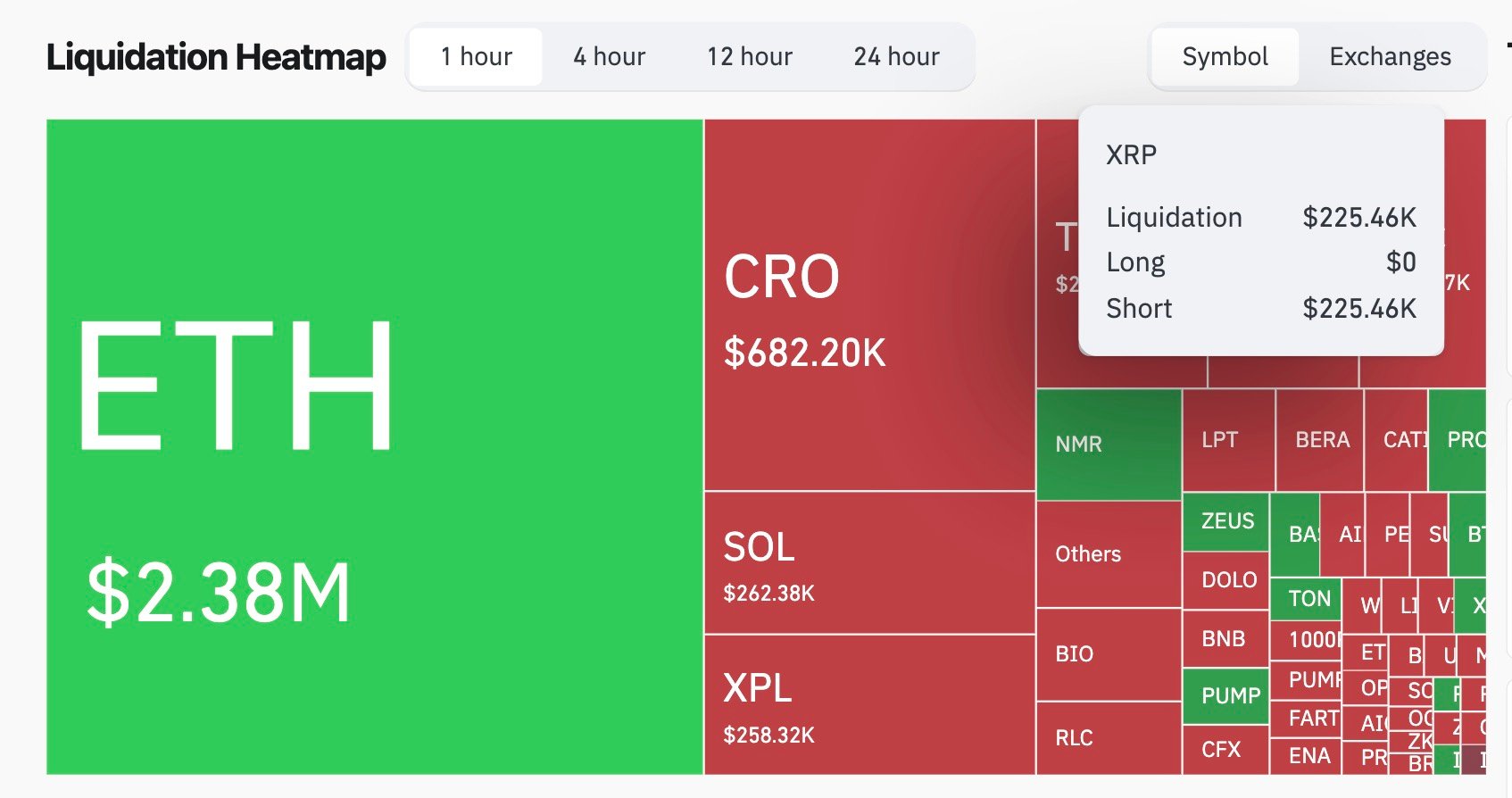XRP experienced an extreme liquidation imbalance after U.S. GDP beat expectations: $225,460 of short positions were liquidated while long liquidations registered $0, producing a near‑infinite imbalance that briefly amplified price volatility around the macro release.
-
Liquidation imbalance: $225,460 shorts vs $0 longs, per CoinGlass data
-
U.S. GDP rose 3.3% q/q, above the 3.1% forecast, triggering volatility across thin XRP order books.
-
Weekly jobless claims at 229,000 and upcoming Non‑Farm Payrolls (Sept. 5) may shape altcoin positioning ahead of the Fed meeting.
XRP liquidation imbalance after U.S. GDP: $225,460 shorts liquidated and rare $0 longs — read concise analysis and what traders should watch next.
What caused the XRP liquidation imbalance after U.S. GDP?
XRP liquidation imbalance followed the U.S. GDP print when a stronger‑than‑expected 3.3% q/q reading triggered concentrated short liquidations while long exposure remained untouched. Thin order books and automated flows amplified small price moves, creating a temporary statistical anomaly in liquidation data.
How did the macro data (GDP and jobless claims) influence XRP volatility?
Front‑loaded macro surprises pushed algorithmic trading systems to rapidly rebalance. U.S. GDP at 3.3% beat forecasts and weekly jobless claims of 229,000 were marginally better than expected. These datapoints favored risk assets briefly and produced clustered volatility in XRP between $3.10 and $3.03 as automated flows cleared shorts.

Source: CoinGlass
CoinGlass reporting recorded $225,460 in short liquidations for XRP while long liquidations registered $0, a rare imbalance. If even $1 had been liquidated on the long side, the calculated imbalance ratio would exceed 22,546,000%—an illustration of how thin liquidity can distort statistics.
During the release hour XRP oscillated quickly, moving from $3.10 down to $3.03 as volatility clusters emerged. These spikes were driven by limited depth in order books and concentrated automated execution. The imbalance lasted only minutes but highlighted market fragility around economic surprises.
When are the next macro events that could affect XRP and altcoins?
The next major release is Non‑Farm Payrolls on Sept. 5 at 3:30 p.m. ET. If labor data remains stable, investors may continue to hold altcoins into the Federal Reserve meeting on Sept. 16–17, potentially supporting an extended altcoin cycle. However, any surprise could rapidly change positioning.
Why does a one‑sided liquidation matter for traders and market structure?
One‑sided liquidations reveal liquidity concentration and execution risk. When shorts are concentrated at similar price levels and order books are thin, automated deleveraging can cascade, creating outsized price moves. Risk managers should watch depth, open interest, and on‑chain funding metrics to gauge vulnerability.
Frequently Asked Questions
How rare is a $0 long liquidation reading?
A $0 long reading is uncommon and typically reflects either a lack of leveraged long exposure at the moment of the event or a distribution of long stops outside the triggered price range. Such readings combined with concentrated short liquidations create statistical outliers.
What should traders monitor after this event?
Traders should monitor order book depth, open interest, funding rates, and upcoming macro releases (Non‑Farm Payrolls, Fed decision). Watching these indicators helps assess the likelihood of renewed volatility and potential altcoin rotation.
Key Takeaways
- Statistical anomaly: $225,460 shorts vs $0 longs produced an extreme imbalance that briefly distorted metrics.
- Macro sensitivity: Stronger U.S. GDP and better jobless claims favored risk assets and triggered automated flows.
- Actionable insight: Monitor order book depth and upcoming labor data to manage execution and risk ahead of the Fed meeting.
Conclusion
The XRP liquidation imbalance after the U.S. GDP surprise underscores how thin liquidity and automated execution can produce outsized, short‑lived disruptions. COINOTAG reports this event to aid traders in preparing for upcoming catalysts, notably Non‑Farm Payrolls and the Federal Reserve meeting. Stay alert to liquidity metrics and macro calendars to navigate similar episodes.
